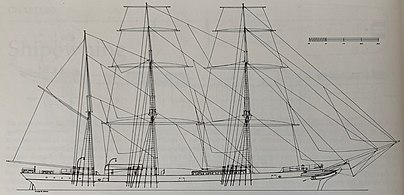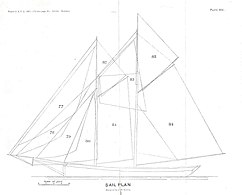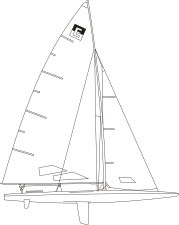
A sail plan is a drawing of a sailing craft, viewed from the side, depicting its sails, the spars that carry them and some of the rigging that supports the rig. By extension, "sail plan" describes the arrangement of sails on a craft. A sailing craft may be waterborne (a ship or boat), an iceboat, or a sail-powered land vehicle.
Purpose

Depending on the level of detail, a sail plan can be a visual inventory of the suit of sails that a sailing craft has, or it may be part of a construction drawing. The sail plan may provide the basis for calculating the center of effort on a sailing craft, necessary to compare with the center of resistance from the hull in the water or the wheels or runners on hard surfaces. Such a calculation involves the area of each sail and its geometric center, referenced from a specific point.
Sail inventory

Considerations for a sail inventory in a yacht include the type of sailing (cruising, racing, passage-making, etc.) and the weather conditions anticipated. An assessment starts with a sail plan that depicts each kind of sail under consideration. The sail plan becomes a guide for which sails to use under the anticipated weather conditions, while under way. Sail names encompass fore-and-aft rigs, square rigs, and rigs that encompass both types.
Fore-and-aft rig
A cutter-rigged yacht, intended for off-shore sailing might have a sail inventory that includes: a mainsail, a roller furling genoa, and a working staysail for most wind conditions, and, for strong winds, a storm staysail and trysail. Sails for lighter winds would include a spinnaker, a drifter, and a mainsail with lighter sail cloth.
Each sail has a separate set of considerations within the plan, for example with a performance sloop one may consider the following about its suit of sails:
- Mainsail: Lazy jacks, reefing points and battens
- Jib: Roller furling or reefing
- Spinnakers and drifters: Draft, weight and (a)symmetry address their applications
Square rig
A square-rigged sailing vessel carries both fore-and-aft sails, the jibs, staysails and mizzen sail, and square sails. Their naming conventions are:
- For jibs, attached to a bow sprit, (from forward, aftwards): flying, outer, and inner jibs, and the fore-topmast staysail, forestaysail, and foresail.
- For staysails between the foremast and the mainmast (from bottom to top): main, main-topmast, main-topgallant, and main-royal (...staysail). Staysails between other masts are similarly named.
- The mizzen sail (or "spanker") is a gaff-rigged, fore-and-aft sail, mounted on the after side of the mizzenmast. It was used to help tack the vessel.
- For square sails (from bottom to top): (fore, main, mizzen) ...sail, lower topsail, upper topsail, topgallant, royal, skysail.
Choice of rig
In the late 19th and early 20th centuries, choosing a sail plan for a displacement watercraft stemmed from the size and tonnage of the vessel, its purpose (working vessel, cargo vessel or yacht) and the anticipated winds in the region where it was expected to sail. In that period, sail plans might start from smallest to largest boat or ship in a hierarchy of sailing rigs:
Yachts
- Catboat with a single sail
- Sloop with mainsail and jib
- Yawl with a small mast behind the steering post
- Ketch with a mizzenmast ahead of the steering post
Working boats and coastal freighters
Ocean-going merchant vessels
- Brig with two square-rigged masts
- Brigantine with square-rigged foremast and fore-and aft mizzen
- Barque with two square-rigged masts and a fore-and-aft mizzen
- Barquentine with one square-rigged mast and two fore-and-aft masts behind
- Full-rigged ship with three or more masts with square sails on each
Gallery
The following sail plans are at various scales.
- Gaff and square-rigged sailing craft
-
 "Sailing carriage", 1785
"Sailing carriage", 1785
-
 Full-rigged clipper ship, Comet, 1851
Full-rigged clipper ship, Comet, 1851
-
 Barque, Fusi Yama, 1865
Barque, Fusi Yama, 1865
-
 Schooner, Grampus, 1887
Schooner, Grampus, 1887
- Racing sailing craft
-
 Sailboard
Sailboard
-
 Byte dinghy
Byte dinghy
-
 470 dinghy
470 dinghy
-
 Flying Dutchman dinghy
Flying Dutchman dinghy
-
 E Scow
E Scow
-
 49er dinghy
49er dinghy
-
 Formula 18 catamaran
Formula 18 catamaran
-
 J Class yacht
J Class yacht
See also
References
- "Sail plan". Collins English Dictionary. 2023.
- ^ Folkard, Henry Coleman (2012). Sailing Boats from Around the World: The Classic 1906 Treatise. Dover Maritime. Courier Corporation. p. 576. ISBN 9780486311340.
- Committee, Cruising Club of America Technical (1987). Desirable and Undesirable Characteristics of Offshore Yachts. W. W. Norton & Company. p. 161. ISBN 978-0-393-03311-3.
- Symonds, A. A. (1938). An Introduction to Yacht Design. E. Arnold & Company. ISBN 978-1-4733-8976-2.
- Hasse, Carol (28 November 2013). "Recommended Offshore Sail Inventory". Cruising World. Retrieved 21 February 2023.
- Greene, Danny (December 1986). Upgrading Your Sail Plan. Cruising World. pp. 47–52.
- Schäuffelen, Otmar (2005). Chapman Great Sailing Ships of the World. Hearst Books. pp. xxvii. ISBN 978-1-58816-384-4.
- Reid, Phillip (18 April 2023). A Boston Schooner in the Royal Navy, 1768-1772: Commerce and Conflict in Maritime British America. Boydell & Brewer. p. 252. ISBN 978-1-78327-746-9.
- "Harvesting the wind". Ocean Navigator. 31 August 2016. Retrieved 23 February 2023.
- Chapelle, Howard I. (1936). Yacht Designing and Planning for Yachtsmen, Students and Amateurs. New York: Norton. ISBN 978-1-4474-8252-9.